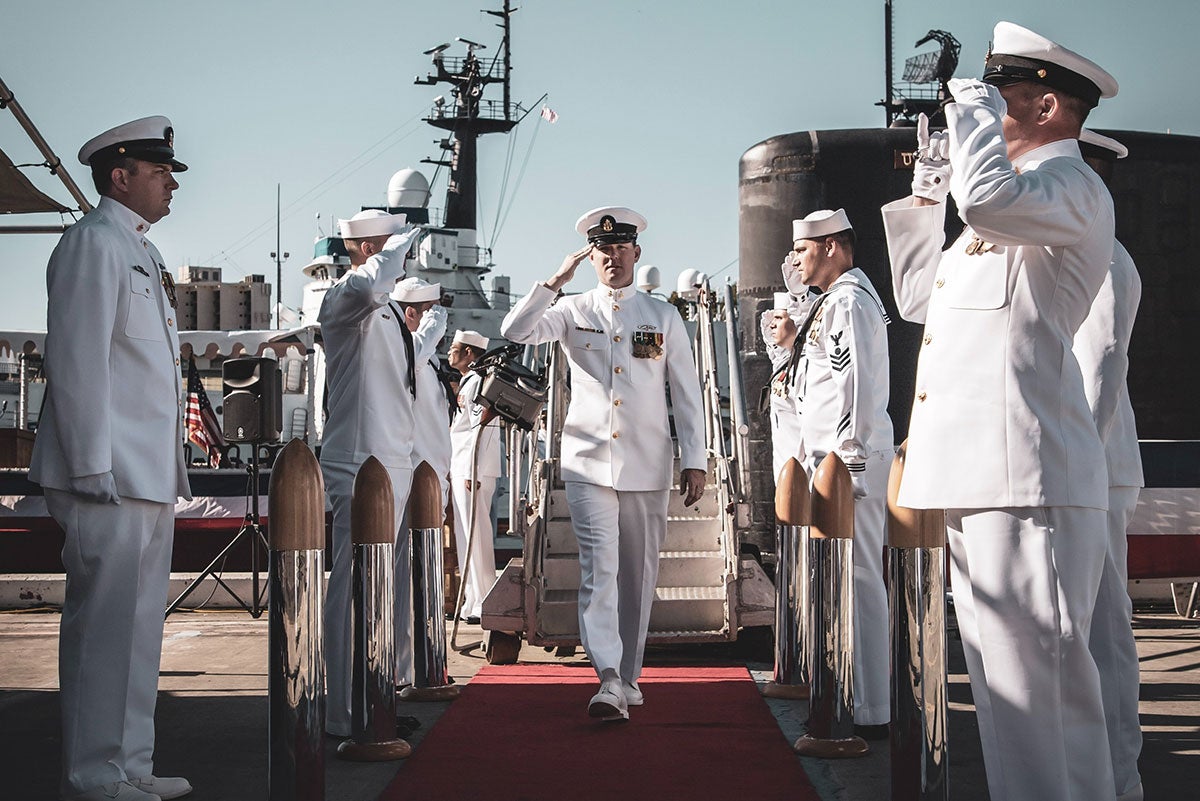A Veteran’s Journey: All Hail the Chief - A Lesson in Leadership
November 10, 2021
By: Jeff Brown
Categories: Colleague Stories
Leadership is definitely about serving. I learned that in the Navy and that is something I advocate here at St. Mary’s.
Today, November 11, is Veterans Day. In observance of this day, St. Mary's Auxiliaries, leaders and colleagues line the driveways of all three of our hospitals with American flags. We salute all those who are serving and who have served in our nation's Armed Forces. We are here to serve you as you served us. Thank you, and God bless.
After I graduated from recruit training, I was assigned to Hospital Corpsman training school, which was located right across the highway from the recruit training center in Great Lakes, Illinois. Given that I had already graduated from an accredited radiology program, there was no way the U.S. Navy was going to waste my training. As I made the arduous one-mile journey to my new home, winter was starting to set in. It was getting cold in North Chicago. It was early December 1987.
Upon arrival, our class was assembled. Our instructors walked in: Lieutenant Soprano (no relation to Tony and the gang), Chief Petty Officer McCleod, and Petty Officer 1st Class Lewis.
As impressive as all three were, Chief McCleod stood out. His uniform was spotless; his shoes were so polished you could see your reflection; the ribbons on his chest were perfectly aligned, and given the few number of service stripes on his lower left sleeve, he had been in the Navy less than 12 years. And yet he had already achieved the rank of Chief Petty Officer. Attaining a rank that high that fast is a very rare accomplishment, especially in the Hospital Corps. You could not help but to be impressed with this man. He spoke with a voice that commanded attention, yet he did not overpower the room.
Rule Number 1: Set expectations
He started by outlining the agenda over the next five months and that his expectation was that our class would be the top graduating class. He would accept nothing less. He stated he would push us hard but when it was all over, we would have accomplished something we could all be proud of. That was it. There were no bonuses, no promotions, no raises, no other incentives. Just pride in knowing you were the best. I bought in right away.
As the leader, he set his expectations immediately. He carried himself in a way that you knew he meant what he said. He entered and left the room as the unquestioned leader without barking, without being announced, and without any need for recognition. He was legit.
He kept his word. He pushed us. The days started early and ended late. Classes started at 5:30 a.m., which meant breakfast was at 5 a.m., which meant you were up and going between 4-4:30 a.m. By week three, you were in the actual hospital in the classroom, located on the 12th floor, for clinicals. Students were not allowed to ride the elevators. Clinicals started at 5:30 a.m. There’s nothing like walking 12 flights of stairs at 5 a.m. to get your day started.
Side note: There is also nothing like the view of the sun coming up over Lake Michigan when it’s frozen over. The sunbeams reflecting off the ice turned the ice different shades of pink, orange, red and purple. From 12 floors up, it was simply beautiful.
Rule Number 2: Think!
My first assignment on a real floor with real patients was PACU – Post-Anesthesia Recovery Unit – where patients who have had surgery go to wake up. I loved it!! It was so different from anything I had done in radiology. My next assignment was pediatrics. I hated it!! I like babies, don’t get me wrong. But I get too emotional. Lesson learned: I am not equipped to handle working in a pediatrics hospital.
Chief McCleod pushed us to become critical thinkers and to do it all: to be able to do patient assessments from head to toe in a flash, to be able to start IV’s and give shots ("Stab Lab" is a story all on its own, but I'll spare you), insert catheters, apply traction in a combat setting, apply MAST [Military Anti-Shock Trousers] trousers, you name it. And we held up our end and graduated as the top class.
Our success was because he set his expectations from the beginning. His instructions were clear. He did not do the work for us, but he did offer instruction along the way and he corrected course when needed. Here’s an example: In the clinical training setting, if he saw you turn your back on a patient and the bedrails were down, he would immediately launch a “patient has fallen out of bed" drill. He would go on for 40 minutes, calling out vital signs and symptoms, and you had to respond. Not only did I become good at patient assessment, but I also remembered to make sure the stupid bedrails were up before I turned my back on a patient. He never yelled at anyone. He just made sure you stayed on task and performed each step of the procedure exactly right.
Rule Number 3: Learn it. Now learn it better.
Leaders need to set expectations for the team. Without expectations, how will the team know what the goals are? As trainees in the Navy's Hospital Corpsman School, we knew that – in some shape, form or fashion – all of us were going to end up taking care of patients. We might be stationed on ships, in clinics, or in hospitals, but patient care was in our future. Chief McLeod set the expectation that we were going to learn it, learn it better, be better, be better equipped to handle situations with no hesitation – and he was going to push us to get us there.
As my time in the Navy ran its course, I had the opportunity to work for many great leaders, including Captain Donald Boye, MD, who was instrumental in me wanting to pursue a path in healthcare administration. Then, as my post-Navy career began to take shape, I was again blessed to have the opportunity to work for many great leaders and, unfortunately some not-so-great leaders. But I learned something from all of them. Some of my key mentors have been right here at St. Mary’s. Again, the path that the voice in my head led me down is still rewarding me.
Servant leadership: More than a cliché
Leadership is definitely about serving. I learned that in the Navy and that is something I advocate here at St. Mary’s. As cliché as that has become, it’s very true. How does a leader serve? By planning, setting goals and expectations, and carrying out that plan. By course-correcting and avoiding getting bogged down. By meaning what you say and following through on what you say you will do.
Leadership is not about a title. If you are in a leadership role for the title or the money, you are in it for the wrong reason and you need to re-evaluate your career choices right now. If you are not serving, you are not leading. As leaders, it is our sacred duty to serve our teams so they can serve others.
Learn more about St. Mary’s Military and Veterans Health Program

Jeff Brown is St. Mary’s Vice President of Support Services and director of St. Mary’s Military and Veterans Health Program. A veteran of the United States Navy, he served as a Petty Officer 2nd Class, Hospital Corpsman, in Europe, the Middle East and stateside.


